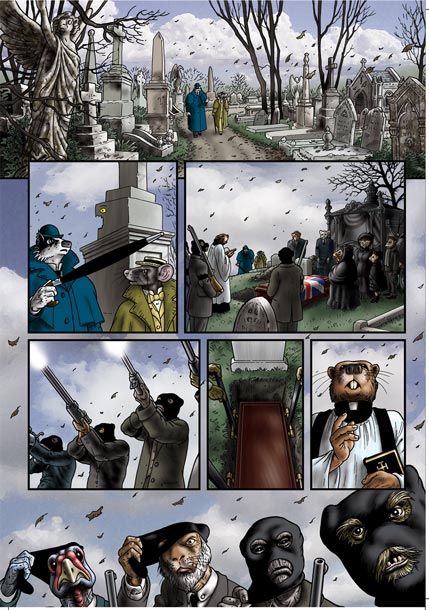Grandville and Grandville Mon Amour are two new comics by Bryan Talbot, published by Dark Horse. Readers may be familiar with Talbot from his art for Sandman and Fables, or his other work such as Alice in Sunderland and The Tale of One Bad Rat. He’s a leading writer/illustrator in the comics world, with quite a variety of types of work under his belt.
These two books have been getting quite a bit of buzz lately in discussions of nominees for the Hugo for Best Graphic Story, and I was lucky enough to have a chance to read them. They’re both hardcovers in red, labeled “A Detective-Inspector Lebrock of Scotland Yard Scientific-Romance Thriller.”
As you may have guessed, the Grandville books are heavy in pastiche and literary reference. I hesitate to call them “steampunk” though I’m sure that’s the easiest designation, because they seem to be leaning further toward Victorian-noir than anything, with a classic French comics sensibility—they are, in fact, “inspired by the work of the French caricaturist named Jean Ignace Isidore Gerard (1803-1847) who worked under the nom de plume J. J. Grandville, and the seminal science-fiction illustrator, fellow Frenchman Albert Robida (1848-1926).”
Oh, and the next line of the acknowledgements page is “Not to mention Sir Arthur Conon Doyle, Rupert the Bear, and Quentin Tarantino.”
While I can’t speak with any authority towards French caricature art, as it is a giant murky ground for me, Talbot’s reportage of his influences lends an interesting angle to the books. I admit, I would have been baffled by the Grandville reference had it not been for that side-note and included illustration at the end of Grandville Mon Amour. (That, and I looked it up. There’s a lengthy history of anthropomorphizing characters in comics, but that’s a topic for another day.) With that note, though, the stories take on another cast: they are commentary and reflection on comics gone by, of potentially unknown histories, while they also tell their scientific/romance thriller tales.
It’s a strange and lovely confluence of things. Art, story, history and background—Talbot weaves them together in a seemingly simple guise. The tales themselves are political intrigues based around his Napoleonic universe, where Britain is a small socialist state that recently won its independence from France and France is the center of the European world. It is a science fiction alternate history with steam engines, automata, zeppelins and a variety of weapons-hardware, but it also has its own social strata arranged along species-lines (“doughfaces,” aka us boring human types, are at the bottom). The first volume is about a murdered diplomat who found out that the French were behind bombings blamed on British anarchists and the second volume delves further into the history British fight for independence and the guilt of various high government figures in a massacre of British citizen-soldiers.
It’s hard to critique noir stories that follow the expected plotlines when they’re engaging with those stories while telling them. Certainly, in the second volume, it’s difficult to believe that Lebrock doesn’t put the evidence together until the very last moment—but it’s exactly what the story structure demands, and the Tarantino sensibilities and pastiche elements within the text make it work. (The same can apply to the female characters, who are mostly harlots or offscreen or needing rescue or being murdered. Normally, that would bother me quite a bit. This particular instance, though—it’s a Victorian setting with Victorian/noir sensibilities, so I can handle it. It’s not likely that women would be visible in the political/law-enforcement scene, or even particularly possible, and that’s where these stories take place.)
I recommend the Grandville books. For someone who gets the references, they’re double-fun, but even as just rip-roaring Victoriana adventures, they’re pretty exciting. The art is eye-catching and colorful, with enough of the weird to make it strange reading in a good way.

Lee Mandelo is a multi-fandom geek with a special love for comics and queer literature. She can be found on Twitter and Livejournal.










